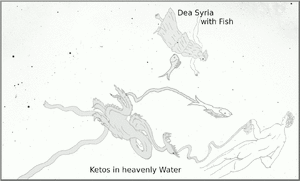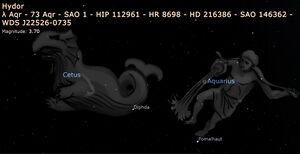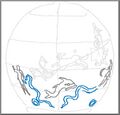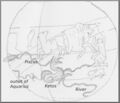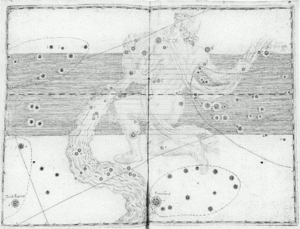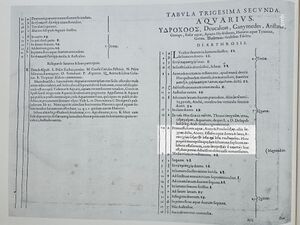Hydor: Difference between revisions
(Created page with "The Ancient Greek term Hydor (ὕδωρ) means "Water". for 2 Cet ==Etymology and History== ==Mythology== ==IAU Working Group Star Names== The name "Hydor (ὕδωρ) is suggested for 2 Cet (HIP 301, HR 9098), a blue star (B9) of 4.536 mag in visible light. In modern star charts, the star is located between the tail of the Cetus-figure and the drops of the outlet of Aquarius. the WGSN chose ... (not to apply/ to apply the name to a neighbouring star/ to ...) in th...") |
|||
| (25 intermediate revisions by 4 users not shown) | |||
| Line 1: | Line 1: | ||
[[File:Hydor Farnese-Stellarium smh2022 anim.gif|thumb|animated GIF of the Cetus region on the Farnese Globe mapped to the Stellarium star chart. The curly lines forming a stream of heavenly water (drawing and implementation by SMH 2024).]] |
|||
The Ancient Greek term Hydor (ὕδωρ) means "Water". for 2 Cet |
|||
[[File:Hydor stellarium-Farnese.gif|alt=star chart with ancient drawings|thumb|The Stellarium sky culture "Farnese Globe" maps the depiction of the ancient marble globe to a modern star chart. The constellation of The River and the asterism of the (water)outlet of Aquarius form a huge watery environment for Cetus, The Seamonster. The northern edge of this area is bordered by the "ribbon" of Pisces of which only the southern part is drawn on the marble globe. The artist who made this globe apparently did not consider Pisces as two fish connected with a ribbon, but the northern one of the two as an attribute of the lady goddess (now: Andromeda) and the other one as a dead fish (belly up) at the edge of the heavenly water ("hydor"). CC-BY SMH 2024]] |
|||
The Ancient Greek term Hydor (ὕδωρ) means "Water". It is a constellation that is only mentioned in Aratus' didactical poem "Phainomena". |
|||
==Etymology and History== |
==Etymology and History== |
||
=== Ancient asterism === |
|||
Aratus (4th century BCE) in his didactic poem "Phainomena" mentions an asterism "The Water" that is mentioned by no other preserved text:<ref>[https://www.theoi.com/Text/AratusPhaenomena.html ARATUS, PHAENOMENA] (online), from: Callimachus, Hymns and Epigrams. Lycophron. Aratus. Translated by Mair, A. W. & G. R. Loeb Classical Library Volume 129. London: William Heinemann, 1921. https://www.theoi.com/Text/AratusPhaenomena.html</ref><ref>Arat, Phainomena, Engl. translation by Kidd, Douglas, Cambridge Univ. Press 1997</ref> <blockquote>Other stars lying scattered below the Water-pourer hang in the sky between the celestial Monster and the Fish, but they are faint and nameless. Close to them, like a light spray of water being sprinkled this way and that from the right hand of the illustrious Water-pourer, some pale and feeble star go round. Among them go two rather brighter stars, not so very far apart nor yet very close, onebeautiful and bright star beneath the two feet of the Water-pourer, the other below the dark Monster's tail. Men call them collectively the Water. (389-399)</blockquote> |
|||
[[File:Hydor stellarium-007.jpg|alt=Stellarium star chart |thumb|lambda Aquarii named "Hydor" in some early modern maps including Bayer's Uranometria (1603), map in Stellarium. Diphda and Fomalhaut also labelled. ]] |
|||
These stars are in the area of the sky between the bright stars Diphda and Fomalhaut, south of the Aquarius and Cetus. |
|||
The three preserved ancient globes<ref>Hipparchs Himmelsglobus – Ein Bindeglied in der babylonisch-griechischen Astrometrie?, [http://www.springer.com/de/book/9783658186821 Springer Research], Wiesbaden/ New York, 2017</ref><ref>Hoffmann, Susanne M. (2024). Some Results on the three Ancient Globes, Globusfreund/ Globe Studies, ISSN </ref> depict this asterism of The Water as a vessel for the monster named "Ketos" in Greek, making it a monster living in the water (sea), a seamonster<ref>Hoffmann, S.M., Vickers, D. and Geymeier, M. (2022). Constellation Cetus: Whale or Monster? , 287</ref>. |
|||
Cicero, Aratea, fr. 33.179 |
|||
Avienus, Aratea, 841 |
|||
Germanicus, Aratea (387-388) omits the name. |
|||
=== Image Gallery === |
|||
<gallery> |
|||
File:CetusCentered Kugel smh framed.jpg|an apparent vessel for Cetus on the Kugel-Globe (drawing SMH 2024), 2nd or 1st century BCE |
|||
File:Hydor Kugel smh2023.jpeg|map of the Kugel Globe, Cetus in the center of two lines with rings, drawing by SMH 2024, 2nd or 1st century BCE |
|||
File:Farnese dasWasser smh sw framed.jpeg|Some lines forming a stream of water in which Cetus is centered on the Farnese Globe (drawing by SMH 2021), 2nd or 1st century CE with Hellenistic predecessor |
|||
File:Hydor Farnese-Stellarium smh2022.jpeg|Figures of the Farnese Globe mapped to the Stellarium star chart (drawing and implementing by SMH 2021). Cetus-region. |
|||
File:Hydor Mainz smh2023.jpeg|map of the Mainz Globe with Cetus in the center, surrounded by many dots (star symbols), perhaps representing The Water (drawing by SMH 2023), 2nd century CE |
|||
</gallery>[[File:Aqr Bayer map Hydor.gif|alt=historical star chart, photograph|thumb|Bayer (1603) map of Aquarius with the star "lambda" highlighted. The adjacent table lists it with the name "Hydor".]] |
|||
=== Star Name (Early Modern) === |
|||
[[File:Aqr Bayer HydorTXT.jpg|alt=screenshot of historical star catalogue|thumb|Bayer (1603) Aquarius star list with the star lambda (highlighted) described as occasionally named "Hydor" (Water) by historical authors.]] |
|||
"Hydor" - water - is the first name listed in Allen (1899) although not transliterated from the Greek to Latin alphabet: "λ, 3.8, red, is the most prominent of the first stars in the Stream. Proclus followed Aratos in calling it Ὕδωρ, [note: Hydor] the Water; and others, Ἔκχυσις, [note: "Ekkhysis"] the Outpouring; Aratos describing it, "Like a slight flow of water here and there, Scattered around, bright stars revolve but small"; although these titles, appropriated by Bayer for λ, originally were for the whole group set apart as the Stream. Allen's description basically repeats Bayer (1603) Uranometria, attributing names to Aratus and Proclus. |
|||
{| class="wikitable" |
|||
|+ |
|||
!Bayer's text for λ Aqr (see image), mixed Greek and Latin |
|||
!translation (English) |
|||
|- |
|||
|Prima effusionis aquae, Arato & Proclo '''ὕδωρ (Lat.: Hydor)''', aliis ἔκχας dicta, Anony. Effusio aquae dexta & laeua, Arato χύσις ὕδατ@ ἔνθα καὶ ἔνθα σκιδναμένϫ, Hinc perperá manupicta quedam schemata duplicem exhibent effusionem, cum ἐπιϛροφὰς ἢ καμπὰς hoc est, duas potius debuissent obseruasse conuersiones. |
|||
| |
|||
|} |
|||
However, the entry is one of many sloppinesses in Allen (1899). The term "Hydor" describes the whole huge region of faint stars around Cetus - it is the element that makes the monster depicted in Cetus a '''''sea'''''monster (because it is in Hydor!). This way, the asterism Hydor is depicted on all three surviving globes from antiquity. |
|||
==Mythology== |
==Mythology== |
||
==IAU Working Group Star Names== |
==IAU Working Group Star Names== |
||
[[File:Psc-Eri-Stream.jpg|thumb|Pisces-Eridanus-Stream, 4731 members with 2 Cet the brightest one in the classical "Water" constellation: This table is sorted by Vmag. ]] |
|||
The name "Hydor (ὕδωρ) is suggested for 2 Cet (HIP 301, HR 9098), a blue star (B9) of 4.536 mag in visible light. In modern star charts, the star is located between the tail of the Cetus-figure and the drops of the outlet of Aquarius. |
|||
As the term Ὕδωρ originally describes an asterism and, thus, a group of many faint stars or an area in the sky, we can apply the name to any star in that area around the figure of Cetus (in Eridanus, Fornax, Cetus, Sculptor, Aquarius - although "For" doesn't make sense). The name "Hydor" (ὕδωρ) is suggested |
|||
* for 2 Cet (HIP 301, HR 9098 [https://simbad.u-strasbg.fr/simbad/sim-id?Ident=2+Cet&NbIdent=1&Radius=2&Radius.unit=arcmin&submit=submit+id SIMBAD]), a blue star (B9) of 4.536 mag in visible light. In modern star charts, the star is located between the tail of the Cetus-figure and the drops of the outlet of Aquarius. Alternatively, i01 Aqr (5.2 mag) or i03 Aqr (5.15 mag), for they are considered today as water drops in the outlet of Aqr. These stars are Psc-Eri-Stream with 4731 members ([https://simbad.cds.unistra.fr/simbad/sim-ref?bibcode=2019A%26A...622L..13M paper]). |
|||
* or for lambda Aqr as preserved in Bayer's Uranometria (1603) which is a red star (M2) of Vmag 3.79 ([https://simbad.u-strasbg.fr/simbad/sim-id?Ident=lam+Aqr&NbIdent=1&Radius=2&Radius.unit=arcmin&submit=submit+id SIMBAD]). However as a bright star in the zodiac, lambda Aqr has multiple cultural aliases that may be more appropriate choices (e.g. Tibetan "Mondru" (Johnson-Groh 2013), Hindu "Satabhisa"/"Satabhisaj"/"Satabhisak" (Venketeswara & Shylaja 2016, Sarma 1997, Rudra 2006)). |
|||
the WGSN chose ... (not to apply/ to apply the name to a neighbouring star/ to ...) in the IAU-CSN. |
the WGSN chose ... (not to apply/ to apply the name to a neighbouring star/ to ...) in the IAU-CSN. |
||
== Weblinks == |
== Weblinks == |
||
* Ridpath, Ian, “[http://www.ianridpath.com/startales/aquarius.html#water Star Tales: online edition]”. |
|||
* |
|||
== Reference == |
== Reference == |
||
[[Category: |
[[Category:Constellation]] |
||
[[Category:Star Name]] |
|||
[[Category:Eurasia]] |
[[Category:Eurasia]] |
||
[[Category: |
[[Category:Ancient Greek]] |
||
Latest revision as of 03:22, 8 November 2024
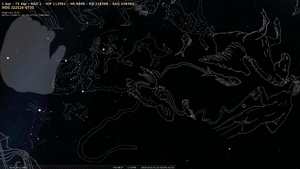
The Ancient Greek term Hydor (ὕδωρ) means "Water". It is a constellation that is only mentioned in Aratus' didactical poem "Phainomena".
Etymology and History
Ancient asterism
Aratus (4th century BCE) in his didactic poem "Phainomena" mentions an asterism "The Water" that is mentioned by no other preserved text:[1][2]
Other stars lying scattered below the Water-pourer hang in the sky between the celestial Monster and the Fish, but they are faint and nameless. Close to them, like a light spray of water being sprinkled this way and that from the right hand of the illustrious Water-pourer, some pale and feeble star go round. Among them go two rather brighter stars, not so very far apart nor yet very close, onebeautiful and bright star beneath the two feet of the Water-pourer, the other below the dark Monster's tail. Men call them collectively the Water. (389-399)
These stars are in the area of the sky between the bright stars Diphda and Fomalhaut, south of the Aquarius and Cetus.
The three preserved ancient globes[3][4] depict this asterism of The Water as a vessel for the monster named "Ketos" in Greek, making it a monster living in the water (sea), a seamonster[5].
Cicero, Aratea, fr. 33.179
Avienus, Aratea, 841
Germanicus, Aratea (387-388) omits the name.
Image Gallery
Star Name (Early Modern)
"Hydor" - water - is the first name listed in Allen (1899) although not transliterated from the Greek to Latin alphabet: "λ, 3.8, red, is the most prominent of the first stars in the Stream. Proclus followed Aratos in calling it Ὕδωρ, [note: Hydor] the Water; and others, Ἔκχυσις, [note: "Ekkhysis"] the Outpouring; Aratos describing it, "Like a slight flow of water here and there, Scattered around, bright stars revolve but small"; although these titles, appropriated by Bayer for λ, originally were for the whole group set apart as the Stream. Allen's description basically repeats Bayer (1603) Uranometria, attributing names to Aratus and Proclus.
| Bayer's text for λ Aqr (see image), mixed Greek and Latin | translation (English) |
|---|---|
| Prima effusionis aquae, Arato & Proclo ὕδωρ (Lat.: Hydor), aliis ἔκχας dicta, Anony. Effusio aquae dexta & laeua, Arato χύσις ὕδατ@ ἔνθα καὶ ἔνθα σκιδναμένϫ, Hinc perperá manupicta quedam schemata duplicem exhibent effusionem, cum ἐπιϛροφὰς ἢ καμπὰς hoc est, duas potius debuissent obseruasse conuersiones. |
However, the entry is one of many sloppinesses in Allen (1899). The term "Hydor" describes the whole huge region of faint stars around Cetus - it is the element that makes the monster depicted in Cetus a seamonster (because it is in Hydor!). This way, the asterism Hydor is depicted on all three surviving globes from antiquity.
Mythology
IAU Working Group Star Names
As the term Ὕδωρ originally describes an asterism and, thus, a group of many faint stars or an area in the sky, we can apply the name to any star in that area around the figure of Cetus (in Eridanus, Fornax, Cetus, Sculptor, Aquarius - although "For" doesn't make sense). The name "Hydor" (ὕδωρ) is suggested
- for 2 Cet (HIP 301, HR 9098 SIMBAD), a blue star (B9) of 4.536 mag in visible light. In modern star charts, the star is located between the tail of the Cetus-figure and the drops of the outlet of Aquarius. Alternatively, i01 Aqr (5.2 mag) or i03 Aqr (5.15 mag), for they are considered today as water drops in the outlet of Aqr. These stars are Psc-Eri-Stream with 4731 members (paper).
- or for lambda Aqr as preserved in Bayer's Uranometria (1603) which is a red star (M2) of Vmag 3.79 (SIMBAD). However as a bright star in the zodiac, lambda Aqr has multiple cultural aliases that may be more appropriate choices (e.g. Tibetan "Mondru" (Johnson-Groh 2013), Hindu "Satabhisa"/"Satabhisaj"/"Satabhisak" (Venketeswara & Shylaja 2016, Sarma 1997, Rudra 2006)).
the WGSN chose ... (not to apply/ to apply the name to a neighbouring star/ to ...) in the IAU-CSN.
Weblinks
- Ridpath, Ian, “Star Tales: online edition”.
Reference
- ↑ ARATUS, PHAENOMENA (online), from: Callimachus, Hymns and Epigrams. Lycophron. Aratus. Translated by Mair, A. W. & G. R. Loeb Classical Library Volume 129. London: William Heinemann, 1921. https://www.theoi.com/Text/AratusPhaenomena.html
- ↑ Arat, Phainomena, Engl. translation by Kidd, Douglas, Cambridge Univ. Press 1997
- ↑ Hipparchs Himmelsglobus – Ein Bindeglied in der babylonisch-griechischen Astrometrie?, Springer Research, Wiesbaden/ New York, 2017
- ↑ Hoffmann, Susanne M. (2024). Some Results on the three Ancient Globes, Globusfreund/ Globe Studies, ISSN
- ↑ Hoffmann, S.M., Vickers, D. and Geymeier, M. (2022). Constellation Cetus: Whale or Monster? , 287
